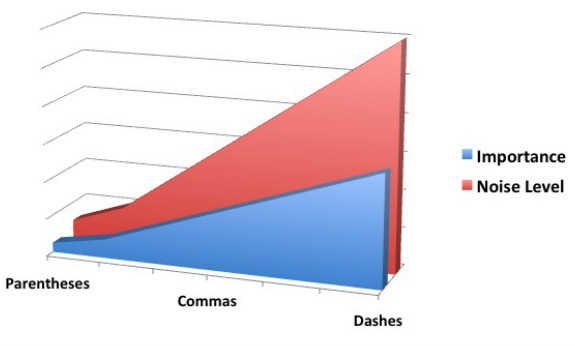Parentheses: These de-emphasize comments, background information, and details. What appears inside parentheses is added information. Leaving it out does not compromise the integrity of your sentence, but does add incidental information. Parentheses always comes in pairs.
In the chart above, parentheses appears as providing the least amount of noise and important information. They act as an aside or a whisper.
Example: This chart (see above) illustrates the ratio of importance and noise level in using three different punctuation marks.
Commas: These are used to modify, qualify, clarify, or add detail to a sentence.
In the chart above, commas are placed in middle ground. Commas don't interrupt the normal flow of a sentence. They act as part of the conversation. They do not act as an aside or as something that needs extra attention.
That being said, there are two ways in which commas behave similarly to parentheses and dashes, but where commas must be used.
1. Non-identifying relative clauses: These are parts of a sentence that give additional information, but not imperative information. The sentence can still function without the added information, and the reader is none the wiser. They do not define the sentence. Non-identifyting relative clauses often start with 'which, 'who', 'whom', and 'whose'. When a non-identifying clause is introduced into a sentence, commas are used.
Example: Alfie, who is one of my two cats, is fluffy and very affectionate.
2. Appositives: Used to introduce other ways for naming what has already been named beside it.
Example: Joey, my brother, works in the gaming industry in Montreal.
Dashes: These are used to add a spotlight to your words. They are meant to interrupt your sentence puposefully as a way to add drama. They are often used as an afterthought; they are used to emphasize comments.
In the chart above, they appear as creating the most noise and importance to a sentence.
Example: The kitten - can you believe it - jumped on top of our roof.
Please keep in mind that these are just some simple and fast guidelines for the uses of parentheses, commas, and dashes, and do not encompass the complexity or leniency that commas (especially) play in the world of writing. A careful writer should think out what he has to say and not just interrupt his sentence as though he just thought of something, as in the use of dashes. Dashes are rarely seen in technical papers, if ever; use parentheses or commas instead.

 RSS Feed
RSS Feed